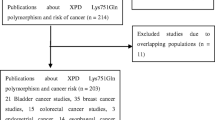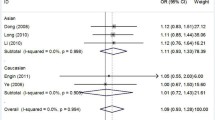Abstract
Xeroderma pigmentosum complementation group C (XPC) gene plays a critical role in DNA damage recognition, and its functional single nucleotide polymorphisms (SNPs) may alter DNA repair capacity and cancer susceptibility. Numerous epidemiological studies have investigated the associations between XPC Lys939Gln and Ala499Val polymorphisms and lung cancer susceptibility, but the conclusions are inconclusive. We searched three electronic databases (MEDLINE, EMBASE and EBSCO) for eligible publications and performed a meta-analysis assessing the associations between XPC Lys939Gln and Ala499Val polymorphisms and lung cancer risk. We also analysed the genotype-mRNA expression correlation using the data of HapMap phase II release 23 with 270 individuals from 4 ethnicities for exploring biological plausibility of our findings. We included ten published studies of 3,882 cases and 5,219 controls for Lys939Gln, and five studies with 2,605 cases and 3,329 controls for Ala499Val. When all studies were pooled, we found a significantly increased overall lung cancer risk for Lys939Gln polymorphism (recessive model: OR = 1.14, 95 % CI = 1.01–1.29, P = 0.218 for heterogeneity). Stratification analysis also showed a higher lung cancer risk in Asian populations (recessive model: OR = 1.26, 95 % CI = 1.04–1.52, P = 0.263 for heterogeneity). Interestingly, we found significant correlation between Lys939Gln genotypes and XPC mRNA expression for Asian populations as well. However, we did not observe any association between Ala499Val polymorphism and overall lung cancer risk, nor in further stratification analysis. This meta-analysis suggests that XPC Lys939Gln polymorphism may contribute to lung cancer risk, which needs further validation in single larger studies.



Similar content being viewed by others
References
Jemal A, Bray F, Center MM, et al. Global cancer statistics. CA Cancer J Clin. 2011;61:69–90.
Shields PG, Harris CC. Cancer risk and low-penetrance susceptibility genes in gene-environment interactions. J Clin Oncol. 2000;18:2309–15.
Geacintov NE, Broyde S, Buterin T, et al. Thermodynamic and structural factors in the removal of bulky DNA adducts by the nucleotide excision repair machinery. Biopolymers. 2002;65:202–10.
Wei Q, Cheng L, Hong WK, Spitz MR. Reduced DNA repair capacity in lung cancer patients. Cancer Res. 1996;56:4103–7.
Gillet LC, Scharer OD. Molecular mechanisms of mammalian global genome nucleotide excision repair. Chem Rev. 2006;106:253–76.
Christmann M, Tomicic MT, Roos WP, Kaina B. Mechanisms of human DNA repair: an update. Toxicology. 2003;193:3–34.
Volker M, Mone MJ, Karmakar P, et al. Sequential assembly of the nucleotide excision repair factors in vivo. Mol Cell. 2001;8:213–24.
Khan SG, Muniz-Medina V, Shahlavi T, et al. The human XPC DNA repair gene: arrangement, splice site information content and influence of a single nucleotide polymorphism in a splice acceptor site on alternative splicing and function. Nucleic Acids Res. 2002;30:3624–31.
Sugasawa K, Ng JM, Masutani C, et al. Xeroderma pigmentosum group C protein complex is the initiator of global genome nucleotide excision repair. Mol Cell. 1998;2:223–32.
Hollander MC, Philburn RT, Patterson AD, et al. Deletion of XPC leads to lung tumors in mice and is associated with early events in human lung carcinogenesis. Proc Natl Acad Sci U S A. 2005;102:13200–5.
Holm K, Melum E, Franke A, Karlsen TH. SNPexp - A web tool for calculating and visualizing correlation between HapMap genotypes and gene expression levels. BMC Bioinforma. 2010;11:600.
Zhu ML, Shi TY, Hu HC, et al. Polymorphisms in the ERCC5 Gene and Risk of Esophageal Squamous Cell Carcinoma (ESCC) in Eastern Chinese Populations. PLoS One. 2012;7:e41500.
International HapMap Consortium (2003) The International HapMap Project. Nature 426 (6968):789–796.
Stranger BE, Forrest MS, Dunning M, et al. Relative Impact of Nucleotide and Copy Number Variation on Gene Expression Phenotypes. Science. 2007;315:848–53.
Mantel N, Haenszel W. Statistical aspects of the analysis of data from retrospective studies of disease. J Natl Cancer Inst. 1959;22:719–48.
DerSimonian R, Laird N. Meta-analysis in clinical trials. Control Clin Trials. 1986;7:177–88.
Egger M, Davey Smith G, Schneider M, Minder C. Bias in meta-analysis detected by a simple, graphical test. BMJ. 1997;315:629–34.
Duval S, Tweedie R. Trim and fill: A simple funnel-plot-based method of testing and adjusting for publication bias in meta-analysis. Biometrics. 2000;56:455–63.
Hu ZB, Wang YG, Ma HX, et al. Association of two exonic genetic polymorphisms in the DNA repair gene XPC with risk of lung cancer in Chinese population. Zhonghua Yi Xue Yi Chuan Xue Za Zhi. 2005;22:415–8.
Hung RJ, Baragatti M, Thomas D, et al. Inherited predisposition of lung cancer: a hierarchical modeling approach to DNA repair and cell cycle control pathways. Cancer Epidemiol Biomarkers Prev. 2007;16:2736–44.
Michiels S, Danoy P, Dessen P, et al. Polymorphism discovery in 62 DNA repair genes and haplotype associations with risks for lung and head and neck cancers. Carcinogenesis. 2007;28:1731–9.
Sakiyama T, Kohno T, Mimaki S, et al. Association of amino acid substitution polymorphisms in DNA repair genes TP53, POLI, REV1 and LIG4 with lung cancer risk. Int J Cancer. 2005;114:730–7.
Hu Z, Wang Y, Wang X, et al. DNA repair gene XPC genotypes/haplotypes and risk of lung cancer in a Chinese population. Int J Cancer. 2005;115:478–83.
Lee GY, Jang JS, Lee SY, et al. XPC polymorphisms and lung cancer risk. Int J Cancer. 2005;115:807–13.
Vogel U, Overvad K, Wallin H, et al. Combinations of polymorphisms in XPD, XPC and XPA in relation to risk of lung cancer. Cancer Lett. 2005;222:67–74.
Bai Y, Xu L, Yang X, et al. Sequence variations in DNA repair gene XPC is associated with lung cancer risk in a Chinese population: a case–control study. BMC Cancer. 2007;7:81.
Chang JS, Wrensch MR, Hansen HM, et al. Nucleotide excision repair genes and risk of lung cancer among San Francisco Bay Area Latinos and African Americans. Int J Cancer. 2008;123:2095–104.
Raaschou-Nielsen O, Sorensen M, Overvad K, et al. Polymorphisms in nucleotide excision repair genes, smoking and intake of fruit and vegetables in relation to lung cancer. Lung Cancer. 2008;59:171–9.
Sakoda LC, Loomis MM, Doherty JA, et al. Germ line variation in nucleotide excision repair genes and lung cancer risk in smokers. Int J Mol Epidemiol Genet. 2012;3:1–17.
Shen M, Berndt SI, Rothman N, et al. Polymorphisms in the DNA nucleotide excision repair genes and lung cancer risk in Xuan Wei, China. Int J Cancer. 2005;116:768–73.
Landi S, Gemignani F, Canzian F, et al. DNA repair and cell cycle control genes and the risk of young-onset lung cancer. Cancer Res. 2006;66:11062–9.
Wood RD. DNA damage recognition during nucleotide excision repair in mammalian cells. Biochimie. 1999;81:39–44.
Thoma BS, Vasquez KM. Critical DNA damage recognition functions of XPC-hHR23B and XPA-RPA in nucleotide excision repair. Mol Carcinog. 2003;38:1–13.
Araujo SJ, Nigg EA, Wood RD. Strong functional interactions of TFIIH with XPC and XPG in human DNA nucleotide excision repair, without a preassembled repairosome. Mol Cell Biol. 2001;21:2281–91.
Araki M, Masutani C, Takemura M, et al. Centrosome protein centrin 2/caltractin 1 is part of the xeroderma pigmentosum group C complex that initiates global genome nucleotide excision repair. J Biol Chem. 2001;276:18665–72.
Wang G, Chuang L, Zhang X, et al. The initiative role of XPC protein in cisplatin DNA damaging treatment-mediated cell cycle regulation. Nucleic Acids Res. 2004;32:2231–40.
Wei Q, Cheng L, Amos CI, et al. Repair of tobacco carcinogen-induced DNA adducts and lung cancer risk: a molecular epidemiologic study. J Natl Cancer Inst. 2000;92:1764–72.
Sanyal S, Festa F, Sakano S, et al. Polymorphisms in DNA repair and metabolic genes in bladder cancer. Carcinogenesis. 2004;25:729–34.
Francisco G, Menezes PR, Eluf-Neto J, Chammas R. XPC polymorphisms play a role in tissue-specific carcinogenesis: a meta-analysis. Eur J Hum Genet. 2008;16:724–34.
Qiu L, Wang Z, Shi X. Associations between XPC polymorphisms and risk of cancers: A meta-analysis. Eur J Cancer. 2008;44:2241–53.
Zhang D, Chen C, Fu X, et al. A meta-analysis of DNA repair gene XPC polymorphisms and cancer risk. J Hum Genet. 2008;53:18–33.
He J, Shi TY, Zhu ML, et al. Associations of Lys939Gln and Ala499Val polymorphisms of the XPC gene with cancer susceptibility: a meta-analysis. Int J Cancer. 2013;133:1765–75.
Liu C, Yin Q, Hu J, et al. A meta-analysis of evidences on XPC polymorphisms and lung cancer susceptibility. Tumour Biol. 2013;34:1205–13.
Zhu ML, Yu H, Shi TY, et al. Polymorphisms in mTORC1 Genes Modulate Risk of Esophageal Squamous Cell Carcinoma in Eastern Chinese Populations. J Thorac Oncol. 2013;8:788–95.
Vodicka P, Kumar R, Stetina R, et al. Genetic polymorphisms in DNA repair genes and possible links with DNA repair rates, chromosomal aberrations and single-strand breaks in DNA. Carcinogenesis. 2004;25:757–63.
Rafnar T, Sulem P, Stacey SN, et al. Sequence variants at the TERT-CLPTM1L locus associate with many cancer types. Nat Genet. 2009;41:221–7.
Yeager M, Orr N, Hayes RB, et al. Genome-wide association study of prostate cancer identifies a second risk locus at 8q24. Nat Genet. 2007;39:645–9.
Haiman CA, Patterson N, Freedman ML, et al. Multiple regions within 8q24 independently affect risk for prostate cancer. Nat Genet. 2007;39:638–44.
Tomlinson I, Webb E, Carvajal-Carmona L, et al. A genome-wide association scan of tag SNPs identifies a susceptibility variant for colorectal cancer at 8q24.21. Nat Genet. 2007;39:984–8.
Zhu ML, Wang M, Shi TY, et al. No Association between TGFB1 Polymorphisms and Late Radiotherapy Toxicity: A Meta-Analysis. PLoS One. 2013;8:e76964.
Conflicts of interest
None.
Author information
Authors and Affiliations
Corresponding author
Rights and permissions
About this article
Cite this article
Zhu, ML., Hua, RX. & Zheng, L. Associations between polymorphisms of the XPC gene and lung cancer susceptibility: a meta-analysis. Tumor Biol. 35, 2931–2939 (2014). https://doi.org/10.1007/s13277-013-1377-8
Received:
Accepted:
Published:
Issue Date:
DOI: https://doi.org/10.1007/s13277-013-1377-8




